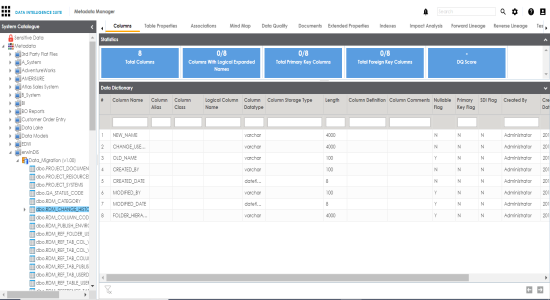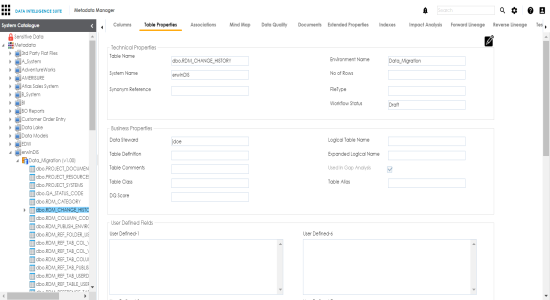Updating Table Properties
Table properties are classified as technical properties and business properties.
You can also define your own new properties using user defined fields.
To update Table Properties, follow these steps:
- Go to Application Menu > Data Catalog > Metadata Manager.
- Under the System Catalogue pane, click a table.
- Click the Table Properties tab.
- Click
 .
. - Enter appropriate values in the fields. Fields marked with a red asterisk are mandatory. Refer to the following table for field descriptions.
- Click
 .
.
The following page appears.

The table properties page appears.

|
Field Name |
Sub-Field |
Description |
|---|---|---|
|
Technical Properties |
Table Name |
Specifies the physical name of the table. For example, Account or Currency. |
| System Name |
Specifies the physical name of the system under which the table exists. For example, Enterprise Data Warehouse. It cannot be edited. |
|
| Synonym Reference |
Specifies the synonym reference for the table. It gets its value while scanning the metadata. You cannot enter it manually. For example, Sales_Rep_Information. |
|
|
Environment Name |
Specifies the physical name of the environment under which the table exists. For example, EDW-Test. It cannot be edited. |
|
|
No of Rows |
Specifies the total number of rows in the table. For example, 100. |
|
|
Workflow Status |
Specifies the workflow status of the table. For example, draft. By default, Metadata_Manager_Default_Workflow_1 is assigned to all the tables in the Metadata Manager. You can create and re-assign a workflow to all the tables in an environment. For more information on workflow status, refer to the Assigning Workflows to Tables topic. |
|
|
Business Properties
|
Data Steward |
Specifies the name of the data steward responsible for the table. For example, Jane Doe. For more information on configuring list of data stewards, refer to the Configuring Data Stewards topic. |
|
Table Definition |
Specifies the definition of the table. For example: The table contains five columns with emp ID column as the primary key. |
|
|
Table Comments |
Specifies comments about the table. For example: The table contains details of the employees. |
|
|
Table Class |
Specifies the table class property. For more information on configuring table class, refer to Configuring Table and Column Class topic. |
|
|
DQ Score |
Specifies the overall data quality score of the table. For example, High (7-8). For more information on configuring DQ scores, refer to the Configuring Data Profiling and DQ Scores topic. |
|
|
Logical Table Name |
Specifies the logical name of the table. For example, if the physical name of a table is DIM_Customer, then the logical name of the table is Customer Dimension. |
|
|
Expanded Logical Name |
Specifies the expanded logical name of the table. For example, if the physical name of a table is RM_Resource, then the expanded logical name of the table is RM Sales Representative. You can configure expanded logical name of tables in bulk at system and environment level. |
|
|
Used in Gap Analysis |
Specifies whether the table is being used as part of a gap analysis to check table usage in mappings. Select the check box if the table is used in gap analysis. For more information on performing table gap analysis, refer to the Performing Table Gap Analysis topic. |
|
|
Table Alias |
Specifies the alias name of the table. For example, Sales_Representative_Table. |
The table properties are updated.
You can use user defined fields with different UI labels. For more information on using UI labels for user defined fields, refer to the Configuring Language Settings topic.
You can also hide or display user defined fields. For more information on hiding or displaying user defined fields, refer to the Displaying User Defined Fields topic.
|
Copyright © 2020 erwin, Inc.
All rights reserved.
|
|